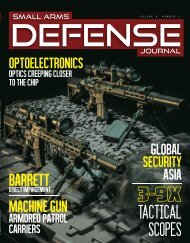Create successful ePaper yourself
Turn your PDF publications into a flip-book with our unique Google optimized e-Paper software.
weapon 2025<br />
General Atomics is working to reduce the<br />
size of land-based mobile systems (Navy<br />
funded a shipboard application), but for<br />
now, it’s big, but it’s also “bad!” The Railgun<br />
can shoot a multipurpose projectile<br />
over a hundred miles with pinpoint accuracy<br />
several times a minute. Future versions<br />
can even shoot ballistic missiles out<br />
of their in-bound trajectory prior to reentry.<br />
The railgun’s long-range projectiles<br />
have a guided capability that gives them<br />
their pinpoint accuracy and allows them<br />
to adjust their path in flight. There are<br />
even special projectiles used for space targets<br />
that contain small maneuver-thrusters<br />
for steering/course correction in a<br />
non-air environment.<br />
As this technology is perfected, we<br />
will undoubtedly see it shrink in size, but<br />
will it ever become man-portable? The scientific<br />
answer is that this technology will<br />
be refined, and at some point, it will become<br />
smaller, lighter and modular. It will<br />
reach a point where the Law of Physics will<br />
limit the reduction of its size and it can go<br />
no smaller. Man portability may never be<br />
attained, but robot modular portability potentially<br />
could, if such a capability was seen<br />
as operationally justifiable and cost effective.<br />
More exciting however, is the likely<br />
refinement in its accuracy and capability<br />
through the use of super sophisticated fire<br />
control computers that are interoperable<br />
with other powerful target detection and<br />
direction systems. While General Atomics<br />
flatly refuses to discuss the potential (and<br />
understandably so), there is no reason why<br />
this gun couldn’t be used to shoot hostile<br />
satellites out of space orbit (with little to<br />
no attack signature). There is also probably<br />
no reason why, if fired from a sea<br />
based, or friendly country’s mobile platforms,<br />
it couldn’t be used to shoot down<br />
hostile ICBMs during the boost stage, or<br />
the orbital phase, or take out the launch<br />
facility all together. Again, the imagination<br />
is the limit for this technology.<br />
Rods from God. So you ask, what is<br />
a “Rod from God?” Quite simply, the rods<br />
are inert (containing no explosive) 20 feet<br />
long one foot diameter finned pole-like<br />
tungsten rods, launched from a spacebased<br />
orbital platform (God), that re-enter<br />
Earth’s gravity with tremendous velocity.<br />
They are guided by the launch satellite<br />
through re-entry and are capable of striking<br />
practically any surface or sub-surface<br />
target (land or sea) anywhere on the face<br />
of the earth. Their destructive force comes<br />
from the high velocity kinetic energy they<br />
deliver on target, comparable to that of a<br />
small nuclear detonation minus the radiation.<br />
Rods from God can easily penetrate<br />
hundreds of feet into solid rock and deliver<br />
a high-energy blast, along with hyper-velocity<br />
shock wave pressures, that effectively<br />
shatters surrounding rock or reinforced<br />
concrete for thousands of feet within the<br />
shock radius. Deep underground structures<br />
(DUGS) within the blast radius cannot<br />
survive no matter how reinforced they<br />
may have been designed.<br />
The satellite carrying multiple rods<br />
can change orbits and altitudes as necessary<br />
bringing the rods to bear above the<br />
targets selected for kinetic bombardment.<br />
It otherwise remains passively in orbit,<br />
waiting for the launch code. Once the rods<br />
are released, the time between re-entry and<br />
impact would only take a few minutes. Additionally,<br />
because the rods present a very<br />
small re-entry signature and they re-enter<br />
at hyper-velocity speeds exceeding Mach<br />
10 at very high angles, they are virtually<br />
impossible to defend against. Countermeasures<br />
for the rods once launched have<br />
yet to be developed. The only countermeasure<br />
is to destroy the orbital launch platform<br />
prior to its launch of the rods.<br />
While the 1979 Strategic Arms Limitation<br />
Talks between the U.S. and the<br />
Soviet Union led to mutual agreement to<br />
prohibit the deployment of third generation<br />
orbital weapons of mass destruction<br />
(nukes) containing Multiple Independently<br />
Targetable Reentry Vehicles (MIRVs),<br />
it did not prohibit the deployment of conventional<br />
weapons. Neither is the Rods<br />
from God system prohibited by either the<br />
Outer Space Treaty that provides the basic<br />
legal framework of international space law<br />
specifically barring party states from placing<br />
weapons of mass destruction in Earth<br />
orbit, installing them on the Moon or any<br />
other celestial body, or to otherwise station<br />
them in outer space.<br />
Electro-magnetic pulse (EMP)<br />
weaponry. Within the grasp of most nuclear-capable<br />
states and non-state actors,<br />
an EMP weapon is an undeniable threat to<br />
modern electronic-dependent infrastructure,<br />
but is it operationally feasible without<br />
attribution and retaliation? The short<br />
answer is no. Nukes are exceedingly expensive<br />
to build and deliver and all have a<br />
specific origin of manufacture fingerprint.<br />
But can a non-nuclear EMP be generated?<br />
The longer answer is yes - and here’s how.<br />
There are a number of natural phenomena<br />
that generate EMP. Sunspots, lightening;<br />
even major earthquakes are some examples<br />
of natural EMP generators. Manmade<br />
examples are nuclear and non-nuclear<br />
EMP generators. While we’re all somewhat<br />
familiar with EMPs resulting from nuclear<br />
detonation and power grid surges, there is<br />
another non-nuclear means to explosively<br />
generate a sizeable EMP and you don’t<br />
need to be a nuclear power to build them.<br />
An explosively-pumped flux compression<br />
generator (EPFCG) is a device used to<br />
generate a high-power electromagnetic<br />
pulse by compressing magnetic flux resulting<br />
from detonating a small conventional<br />
high explosive charge. The compression<br />
process resulting from the explosion,<br />
transforms the chemical energy of the explosives<br />
into the energy of an intense magnetic<br />
field that correspondingly produces<br />
a large electric current electromagnetic<br />
pulse. Because an EPFCG is physically destroyed<br />
by the explosive charge that is used<br />
to generate its pulse, it can be used only<br />
once. A very formidable EPFCG package<br />
small enough to be easily man-carried can<br />
produce a pulse in the range of millions of<br />
amperes and tens of terawatts, exceeding<br />
the power of a lightning strike by orders of<br />
magnitude. Most EPFCG designs require a<br />
starting current pulse to operate, usually<br />
supplied by a bank of high capacity capacitors.<br />
One or more of these EMP weapons<br />
detonated in the heart of any major city<br />
will result in massive EMP destruction<br />
and/or interruption of all systems that are<br />
electronically reliant.<br />
Electro-muscular disabling<br />
technology. A potential less-than-lethal<br />
technology being pursued today by a<br />
small privately funded firm involves electro-muscular<br />
incapacitation. Their patented<br />
technology induces a very select waveform<br />
into the body’s spinal cord, shutting<br />
down the individual’s Sympathetic Nervous<br />
System’s “fight and flight” ability<br />
without affecting the higher portion of the<br />
Autonomic Nervous System’s (ANS) ability<br />
to keep a person’s heart beating or one’s<br />
respiration. Currently, physical contact is<br />
necessary to induce this waveform into the<br />
body but there is talk of using directed energy<br />
to induce this waveform. Obviously, if<br />
an attack on a particular part of the ANS<br />
is possible, they could likewise attack the<br />
part that controls the heart and breathing<br />
and like Star Trek, with a simple click of<br />
a switch, select a stun or kill mode. If this<br />
could be achieved using a directed energy<br />
beam, a weapon such as this could be<br />
as monumental to modern warfare as the<br />
42 SADEFENSEJOURNAL.COM









